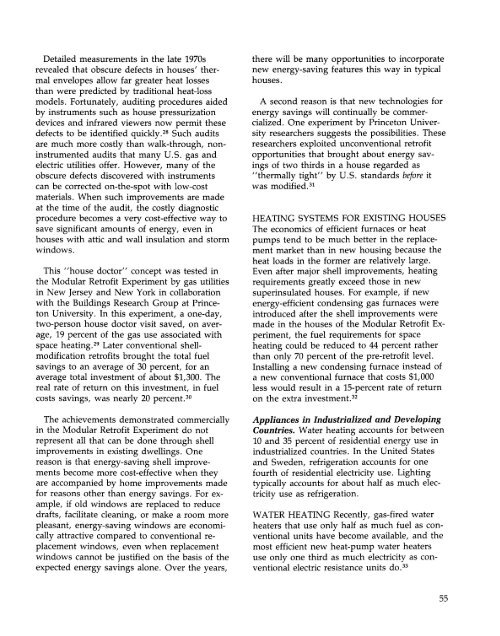ENERGY FOR A SUSTAINABLE WORLD - World Resources Institute
ENERGY FOR A SUSTAINABLE WORLD - World Resources Institute
ENERGY FOR A SUSTAINABLE WORLD - World Resources Institute
Create successful ePaper yourself
Turn your PDF publications into a flip-book with our unique Google optimized e-Paper software.
Detailed measurements in the late 1970s<br />
revealed that obscure defects in houses' thermal<br />
envelopes allow far greater heat losses<br />
than were predicted by traditional heat-loss<br />
models. Fortunately, auditing procedures aided<br />
by instruments such as house pressurization<br />
devices and infrared viewers now permit these<br />
defects to be identified quickly. 28 Such audits<br />
are much more costly than walk-through, noninstrumented<br />
audits that many U.S. gas and<br />
electric utilities offer. However, many of the<br />
obscure defects discovered with instruments<br />
can be corrected on-the-spot with low-cost<br />
materials. When such improvements are made<br />
at the time of the audit, the costly diagnostic<br />
procedure becomes a very cost-effective way to<br />
save significant amounts of energy, even in<br />
houses with attic and wall insulation and storm<br />
windows.<br />
This "house doctor" concept was tested in<br />
the Modular Retrofit Experiment by gas utilities<br />
in New Jersey and New York in collaboration<br />
with the Buildings Research Group at Princeton<br />
University. In this experiment, a one-day,<br />
two-person house doctor visit saved, on average,<br />
19 percent of the gas use associated with<br />
space heating. 29 Later conventional shellmodification<br />
retrofits brought the total fuel<br />
savings to an average of 30 percent, for an<br />
average total investment of about $1,300. The<br />
real rate of return on this investment, in fuel<br />
costs savings, was nearly 20 percent. 30<br />
The achievements demonstrated commercially<br />
in the Modular Retrofit Experiment do not<br />
represent all that can be done through shell<br />
improvements in existing dwellings. One<br />
reason is that energy-saving shell improvements<br />
become more cost-effective when they<br />
are accompanied by home improvements made<br />
for reasons other than energy savings. For example,<br />
if old windows are replaced to reduce<br />
drafts, facilitate cleaning, or make a room more<br />
pleasant, energy-saving windows are economically<br />
attractive compared to conventional replacement<br />
windows, even when replacement<br />
windows cannot be justified on the basis of the<br />
expected energy savings alone. Over the years,<br />
there will be many opportunities to incorporate<br />
new energy-saving features this way in typical<br />
houses.<br />
A second reason is that new technologies for<br />
energy savings will continually be commercialized.<br />
One experiment by Princeton University<br />
researchers suggests the possibilities. These<br />
researchers exploited unconventional retrofit<br />
opportunities that brought about energy savings<br />
of two thirds in a house regarded as<br />
"thermally tight" by U.S. standards before it<br />
was modified. 31<br />
HEATING SYSTEMS <strong>FOR</strong> EXISTING HOUSES<br />
The economics of efficient furnaces or heat<br />
pumps tend to be much better in the replacement<br />
market than in new housing because the<br />
heat loads in the former are relatively large.<br />
Even after major shell improvements, heating<br />
requirements greatly exceed those in new<br />
superinsulated houses. For example, if new<br />
energy-efficient condensing gas furnaces were<br />
introduced after the shell improvements were<br />
made in the houses of the Modular Retrofit Experiment,<br />
the fuel requirements for space<br />
heating could be reduced to 44 percent rather<br />
than only 70 percent of the pre-retrofit level.<br />
Installing a new condensing furnace instead of<br />
a new conventional furnace that costs $1,000<br />
less would result in a 15-percent rate of return<br />
on the extra investment. 32<br />
Appliances in Industrialized and Developing<br />
Countries. Water heating accounts for between<br />
10 and 35 percent of residential energy use in<br />
industrialized countries. In the United States<br />
and Sweden, refrigeration accounts for one<br />
fourth of residential electricity use. Lighting<br />
typically accounts for about half as much electricity<br />
use as refrigeration.<br />
WATER HEATING Recently, gas-fired water<br />
heaters that use only half as much fuel as conventional<br />
units have become available, and the<br />
most efficient new heat-pump water heaters<br />
use only one third as much electricity as conventional<br />
electric resistance units do. 33 55

















